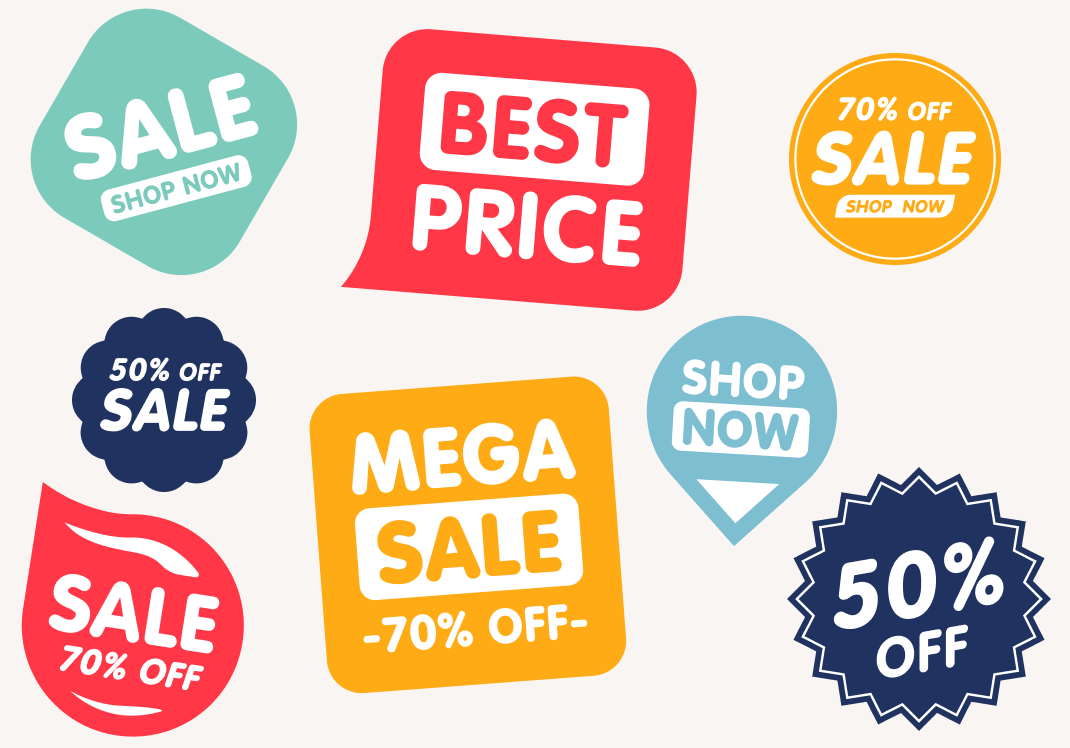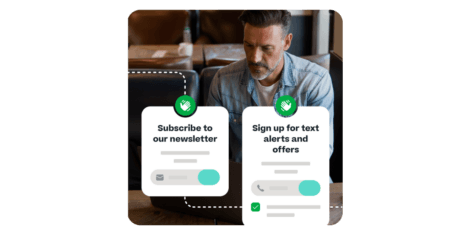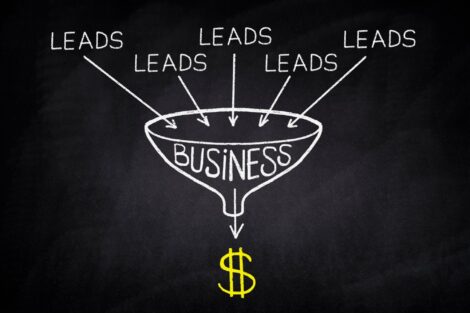Do you need help coming up with lead magnet ideas that your audience would be interested in? Using lead magnets is the key to raising your conversion rates. Whether it’s offering a coupon code or downloadable content, your lead magnet can be a deciding factor in how many new leads you bring in, as well as the quality of those leads.
Lead Magnet FAQs
A lead magnet can be anything you want it to be; it’s something you give away in exchange for contact information of prospective customers. Common examples include discounts, trials, samples, content, etc.
Yes! Giving prospective customers something in exchange is an essential part of your marketing efforts. Lead magnets help build your email/SMS database, allow you to collect zero-party data on subscribers, increase sales, and more.
Pick something that your target audience would find appealing and of equal value to their contact information. Something that educates them, saves them money, gives them a snapshot of your product, etc.
In this post, we’re answering the question “What is a lead magnet?”, explaining what a lead magnet landing page is, sharing tips and best practices on how to create great lead magnets, and more.
What Is A Lead Magnet?
A lead magnet is a free resource, piece of content, or exclusive deal offered to customers in exchange for their contact information. The customer must enter their email address, name, and/or company information to access the lead magnet. eBooks are the most popular lead magnet, with 27.7% of marketers using them, followed by free tools (21.3%), and webinars (24.9%).
According to research, lead magnets are very powerful lead-generation tools: 50% of marketers report seeing higher conversion rates when using lead magnets. They are crucial for your sales funnel in digital marketing because they help build email lists, build customer relationships, and boost sales.
What Is A Lead Generation Landing Page?
A landing page, also called a “lead capture page,” is a web page created to showcase a particular marketing campaign or promotion. When visitors who have clicked on organic or paid ads “land” on this page, they have the option of engaging more profoundly with the company.
A lead capture page doesn’t send visitors to other pages on your site to find out more about your company. Instead, it is created specifically to collect contact details from website visitors (particularly a name and email address) by using a lead magnet to incentivize them.
Why Every Business Needs A Lead Magnet
Regardless of whether you run an eCommerce store or just a small blog, if you want to generate leads, you need a lead magnet.
This is because you need a secondary way to communicate with your website visitors. When it comes to brand-new/first-time visitors, we recommend using a lead magnet to collect email subscribers. Email is a relatively low lift ask for consumers to provide. People will share their email addresses if you provide them with a nice reward, even if they don’t know your brand yet. Unlike other more personal channels like SMS, push notifications, or even social media handles.
You can use other more valuable lead magnets in exchange for those channels later on once you’ve had a chance to develop the relationship more. But that can’t happen without their email–so let’s focus on lead magnets for email marketing.
When used properly, a lead magnet can have a number of benefits:
- It establishes your company’s expertise on a niche subject.
- It increases trust, providing a chance to nurture a potential client relationship.
- Instead of just marketing and selling, it shows that you are interested in meeting your customers’ needs.
- It’s the simplest and most efficient approach to growing your email list or other channels
10 Lead Magnet Ideas To Use On Your Lead Capture Page
Here’s a list of ten great lead magnet ideas that you can use on dedicated landing pages for maximum conversion rates:
- Case Studies: Offer prospective customers in-depth data based on actual events that can help them solve their problems. Prospects near the bottom of the funnel benefit greatly from this kind of lead magnet because it can be the final push they need to convert to paying customers. This is a form of social proof that gives them confidence that others like them saw positive results, and they can expect to as well.
- Cheatsheets: Are documents that offer a condensed explanation of a difficult subject. It would be beneficial to provide a downloadable cheat sheet to your users when they are working on something complex or tedious that takes some time to understand. This kind of quick assistance, which people can have at any time, might be a very effective lead magnet for TOFU-stage visitors as opposed to more in-depth content pieces for the BOFU.
- Guides: An in-depth downloadable guide is a great way to provide a thorough explanation of a subject that your target audience is interested in. Guides are similar to eBooks, and they can work well when you use them as the nurturing stage of your funnel to educate prospective customers on why they should do business with you.
- Free Tools. Tools make fantastic lead magnets because they can save your prospects time and help them discover important insights. If you lack the resources to create your own tool, consider putting together a resource that lists your favorite tools and where you can get them.
- Templates. A template can provide an outline or some starting point, so all the user needs to do is fill in the blanks. If you have a library of templates, consider giving away one of them as a teaser and asking for an email address in order to access the rest.
- Free Trials are frequently used as B2B lead magnets because they are very effective. Customers are often willing to offer their personal contact details in exchange for the opportunity to test out a product or service for free. Consider restricting the duration of your free trial to 14 days. This will give your prospects ample time to evaluate the worth of your offering, and even if they decide not to stay with you, they will at least become a lead.
- Coupons. DTC brands and other consumer businesses commonly use these. They’re effective at the bottom of the sales funnel because the majority of online shoppers like to shop around for discounts and special deals. Your brand should be there to provide those individuals with what they are looking for in exchange for contact information.
- Quizzes. Quizzes work great as lead magnets because they manage to strike a balance between value and fun quite well. In fact, the average quiz has a lead capture rate of 31.6%! You can require people to provide their contact information before they take the quiz, or you can choose to withhold the quiz’s results until the prospect provides their information. Plus, use the zero-party data you collected to instantly personalize welcome flows and uncover additional insights about your target audience.
- Infographics. Long-form content is the most popular type of lead magnet, but you might not have the time to create case studies or ebooks. If this is the case, think about showcasing important information from your existing pieces of content in an understandable, appealing infographic that people will be able to download in exchange for their email addresses. Another great example for TOFU-stage visitors who aren’t necessarily ready for in-depth content but can be a great way to position your business as a thought leader in the space.
- White Papers. A white paper is often lumped in with guides/eBooks, but it’s a bit more in-depth and authoritative. White papers are traditionally made up of original research conducted by your company on an industry subject and are a resource for subject matter expertise. An example would be a consumer survey for shopping habits if you’re a SaaS company like us, like our 2023 consumer trends report for holiday shopping.
What Makes a Good Lead Magnet?
There are a few things that your lead magnet should do if you want your prospects to find it irresistible. A good lead magnet should be:
Specific. Don’t make a lead magnet about a general topic. The more clearly you can articulate the benefits of your lead magnet, the easier it will be to convert your visitors into leads. It would be even greater if you could personalize your lead magnet to a specific lead capture page.
Helpful. A lead magnet is helpful when it focuses on the customer. It should solve a problem, provide a unique insight, or save your prospects time. Another way to think of this is value–in the prospect’s eyes the lead magnet should be of equal value to what you’re asking for.
Instantly accessible and easy to digest. Your lead magnet will perform best if it can be provided right away. It should also be easy to digest. Over 58% of marketers claim that short-form lead magnets, like newsletters, infographics, and checklists, make for the highest conversion rates, whereas only 41% claim that long-form lead magnets (white papers, guides, reports, etc.) make for the highest conversion rates.
Credible. Ideally, your lead magnet should either establish or reinforce your company’s credibility. It should provide reliable information that is supported by research, interviews, and experience. Essentially, does it help answer their question, “Will this solve my problem?”
Shareable. If the lead magnet is useful and credible, your target customers will want to share it. You can make it simple for people to spread the word by including social sharing buttons on your lead magnet landing page and/or linking to it from a social media ad that followers can share.
How To Create Great Lead Magnets For Landing Pages
The type of resource you provide is merely one factor in your lead magnet’s success. You also need to eliminate any barriers that can stop potential customers from accessing and downloading your resource. Here are a few tips and best practices to attract more leads:
1. Make Sure Your Lead Magnets Are Targeted
For a lead magnet to be effective, it must be highly targeted. If you include a generic lead magnet on your opt-in form, you risk gathering leads that are unrelated to your business or just more low-intent than other visitors.
The first step is to understand your target audience’s needs and the problems they are experiencing. If you don’t already have a customer persona, now is a good time to develop one. You can do this based on existing data on your target audience, direct customer feedback, and competitor research.
Use a website personalization tool like Justuno, which can help you target these customer personas with the right experience and messaging. Our 80+ advanced targeting rules make this easy, and one of the most effective is using UTMs! Target top-of-the-funnel traffic when they come to your landing page is by traffic source. It’s pretty much the only thing you know about them, and where they came from can tell you a lot!
Show different lead magnets to different visitors–if they clicked through an ad offering 20% off, show them that vs. those who clicked through an ebook campaign.
2. Use Different Lead Magnets For Different Stages Of The Sales Funnel
Once you are aware of your target audience’s pain points, help them find the solutions they are looking for. However, be sure the piece of content (lead magnet) you’re offering caters to prospects at particular stages of the conversion funnel.
For example, bottom-of-the-funnel (BOFU) content is reserved for leads who are almost ready to make a purchase. All you have to do is persuade them that your offering is better than all of the alternatives out there and is worth their money. BOFU content (or a lead magnet) can be free trial access or a whitepaper describing the features of your product or service.
3. Minimize Friction On The Opt-In Form
Your opt-in form is the place where you actually collect leads. Even the most attractive lead magnets will fail if the contact form is too complex or too long. Keep the required information simple and strive to use as few fields as you can. Usually, just your first name and email address will suffice.
But it’s worth A/B testing to find the right mix of fields that maximizes list growth while also offering a zero-party data collection opportunity. Anything you do add to the lead capture, though–make sure you have a plan for how to use it (and actually do it).
Our customer, Snow Monkey, added a zip-code field to their lead capture. They knew as they expanded into stores, they wanted to unite the e-commerce experience with brick-and-mortar. When they were stocked in a grocery store near subscribers, they sent a geo-targeted email out letting them know where. Adding this field didn’t hurt their opt-in rates; in fact, their email database grew 5X during this time.
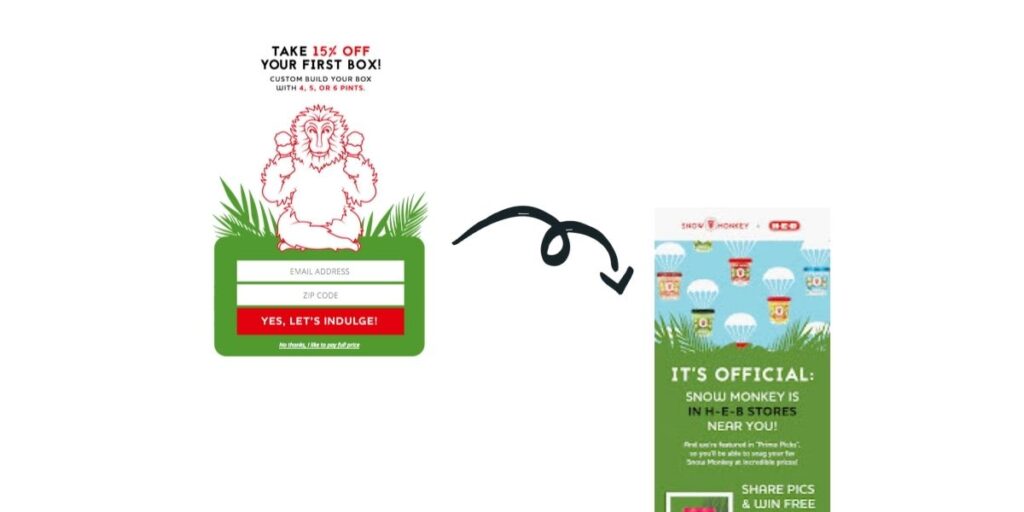
People will also be hesitant to complete your form if it doesn’t feel secure enough. Therefore, be sure to promise not to spam them and, if possible, display a security certificate to ensure them that you won’t use their information carelessly. It shows the consumer respect and credibility, both of which are essential for converting them.
4. Make Sure To Describe The Value Of Your Offer
Your lead magnet landing page needs to convince the visitor to take action (i.e. download your lead magnet). In order to achieve this, your lead capture page must persuasively argue the merits of the resource you’re offering.
The most effective lead magnet landing page pinpoints a relatable issue that your target audience is facing and then explains how your lead magnet can help solve that issue. The headline is usually a great place to highlight the lead magnet’s main benefit.
Once you’ve captured your prospects’ attention with a compelling headline, use body content to succinctly and clearly explain the key components of your lead magnet. This will not only help potential leads understand it better, but it will also dispel any doubts they may have and position your lead magnet as a solution for their pain points.
5. Make Your Lead Magnet Visual
Lead capture pages with videos and images perform better than plain text. In fact, video lead magnets often produce the highest conversion rates, according to GetResponse and the Content Marketing Institute.
This is because, compared to text-based lead magnets, videos are far easier for people to consume, offer quicker gratification, engage more senses, and accommodate a wider range of learning preferences.
The good news is you don’t necessarily have to spend a lot of time and money creating the visuals for your lead magnet. Videos about your company or pictures of your products or customers can be very effective when it comes to attracting attention.
You can create a unique how-to video that helps visitors solve a problem and gate it with an email, share a short business story, or make a sales pitch with an invitation to download the lead magnet. This is where A/B testing comes in handy to find the most effective images and/or videos for your lead magnets.
Our customers see a lot of success when they embed videos directly into their pop-ups. Below is an example from a client, Ruti, who used a short video clip to drive new visitors into their virtual fitting rooms for a personalized shopping experience. The result? A 15X conversion increase.
6. Pay Attention To Your CTA Button
Your CTA (call-to-action) button should be as straightforward as possible in order to grab visitors’ attention and encourage them to take action and click on it. The call to action should provide the visitor with clear instructions regarding what they should do and what they will accomplish after clicking the button.
Pick phrases that are interesting and simple to understand. For instance, while it’s okay to use calls to action like “Sign Up” or “Download Now” you will likely get far better results if you use personalized phrases like “Start My Free Trial” or “Yes! Send My Free Guide!”.
The example below shows a highly branded CTA on a lead magnet intended for first-time customers. It’s memorable, well-designed, and starts the relationship off on the right foot.
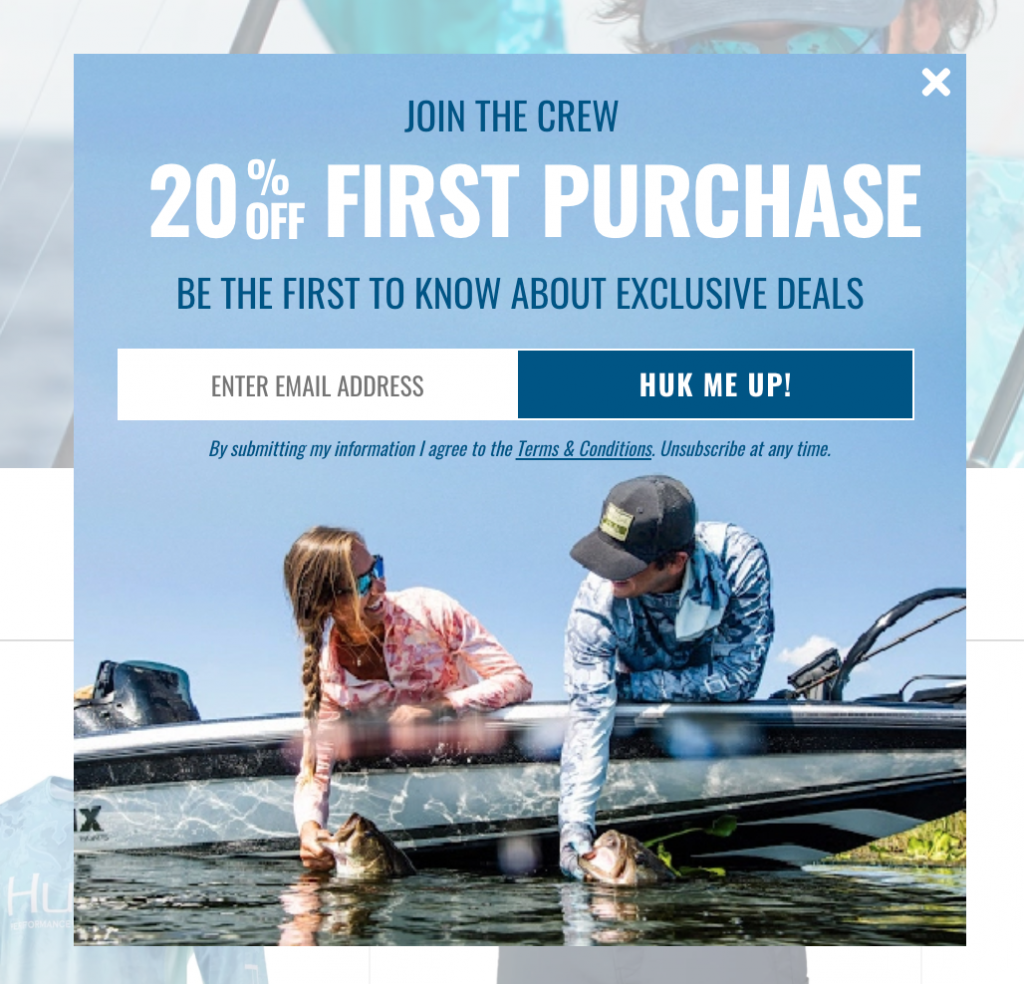
When it comes to the CTA button’s placement, it should be noted that placing it next to your opt-in form might boost lead generation rates by a massive 1617%! Finally, make sure your CTA button stands out and draws instant attention by making it a different color from the rest of the page.
7. A/B Test Your Lead Magnets
If your lead magnet isn’t working as expected, it might be wise to A/B test different components in order to identify any potential friction points. Start your testing with one variable at a time, such as a call to action button, interactive form element, or value propositions, and measure the conversion rates for each one of them.
You can also try different types of lead magnets, as well as the placement, design, and usefulness of your capture forms to see which option performs best.
The Bottom Line
Making a strong lead magnet will help you grow your email list and turn your visitors into customers. By using the tips we’ve shared in this article, you can build great lead magnets that generate leads.
So, put them to work. Create your lead magnet right away and use Justuno’s dynamic landing pages and lead capture to personalize your website’s UX and begin attracting potential customers to your page with just a few clicks.
